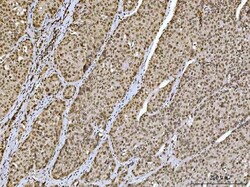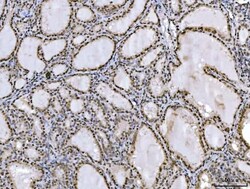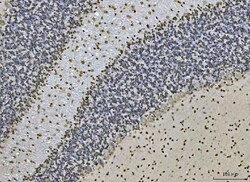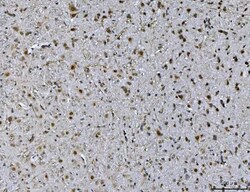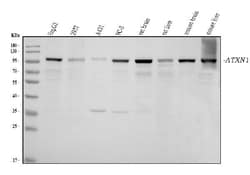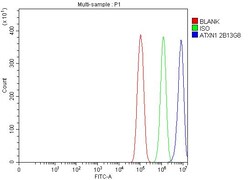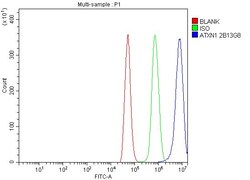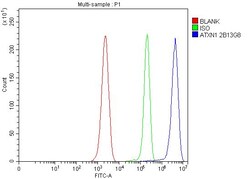Learn More
Invitrogen™ Ataxin 1 Monoclonal Antibody (2B13G8)
Mouse Monoclonal Antibody
Supplier: Invitrogen™ MA549210
Description
Adding 0.2 mL of distilled water will yield a concentration of 500 μg/mL. Immunogen sequence is different from the related and rat sequences by one amino acid. Positive Control - WB: human HepG2 whole cell, human 293T whole cell, human A431 whole cell, human PC-3 whole cell, rat brain tissue, rat liver tissue, mouse brain tissue, mouse liver tissue. IHC: human hepatocellular carcinoma tissue, human laryngeal squamous cell carcinoma tissue, human thyroiditis tissue, mouse brain tissue, rat cerebellum tissue. Flow: PC-3 cell, ANA-1 cell, NRK cell. Store at -20°C for one year from date of receipt. After reconstitution, at 4°C for one month. It can also be aliquotted and stored frozen at -20°C for six months. Avoid repeated freeze-thaw cycles.
The autosomal dominant cerebellar ataxias (ADCA) are a heterogeneous group of neurodegenerative disorders characterized by progressive degeneration of the cerebellum, brain stem and spinal cord. Clinically, ADCA has been divided into three groups: ADCA types I-III. ADCAI is genetically heterogeneous, with five genetic loci, designated spinocerebellar ataxia (SCA) 1, 2, 3, 4 and 6, being assigned to five different chromosomes. ADCAII, which always presents with retinal degeneration (SCA7), and ADCAIII often referred to as the pure cerebellar syndrome (SCA5), are most likely homogeneous disorders. Several SCA genes have been cloned and shown to contain CAG repeats in their coding regions. ADCA is caused by the expansion of the CAG repeats, producing an elongated polyglutamine tract in the corresponding protein. The expanded repeats are variable in size and unstable, usually increasing in size when transmitted to successive generations. The function of the ataxins is not known. This locus has been mapped to chromosome 6, and it has been determined that the diseased allele contains 41-81 CAG repeats, compared to 6-39 in the normal allele, and is associated with spinocerebellar ataxia type 1 (SCA1). At least two transcript variants encoding the same protein have been found for this gene.
Specifications
| Ataxin 1 | |
| Monoclonal | |
| 500 μg/mL | |
| PBS with 4mg trehalose and no preservative | |
| P54253, P54254, Q63540 | |
| ATXN1 | |
| A synthetic peptide corresponding to a sequence at the C-terminus of human Ataxin 1(778-808aa ESRKLEKSEDEPPLTLPKPSLIPQEVKICIE). | |
| 100 μg | |
| Primary | |
| Human, Mouse, Rat | |
| Antibody | |
| IgG2b |
| Flow Cytometry, Immunohistochemistry (Paraffin), Western Blot | |
| 2B13G8 | |
| Unconjugated | |
| ATXN1 | |
| 2900016G23Rik; alternative ataxin1; ataxin 1; Ataxin1; ataxin-1; Atx1; Atx-1; Atx-1-PB; Atxn1; C85907; CG4547; CG4547-PB; D6S504E; dAtx-1; Dmel\CG4547; Dmel_CG4547; ENSMUSG00000074917; Gm10786; OTTHUMP00000016065; SCA1; spinocerebellar ataxia 1; spinocerebellar ataxia 1 homolog; spinocerebellar ataxia type 1 protein; Spinocerebellar ataxia type 1 protein homolog | |
| Mouse | |
| Antigen affinity chromatography | |
| RUO | |
| 20238, 25049, 6310 | |
| -20°C | |
| Lyophilized |
Your input is important to us. Please complete this form to provide feedback related to the content on this product.

